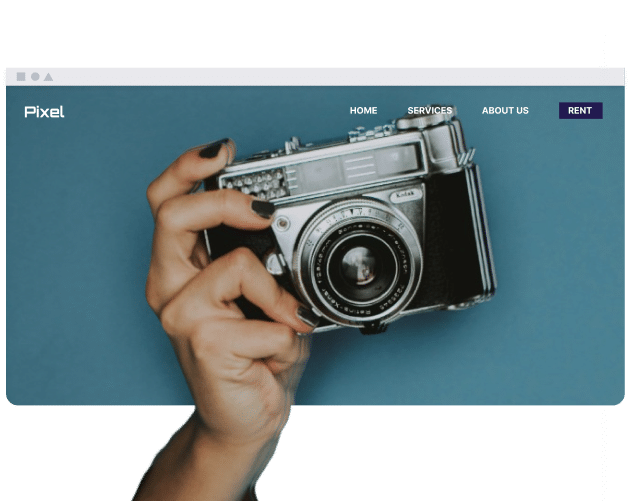Quali sono gli elementi chiave di una buona navigazione del blog?
La navigazione del blog include varie componenti che influiscono sull'usabilità del blog. Questi aspetti fondamentali contribuiscono a modellare l'interazione e la navigazione dell'utente in tutto il sito:
- Menu principale: Di solito si tratta di una barra orizzontale in alto, che fornisce link principali a sezioni chiave come le categorie, la pagina "Chi siamo" e i contatti.
- Barra di ricerca: Questa funzione consente agli utenti di individuare argomenti o contenuti inserendo termini in un campo di ricerca visibile.
- Link interni: Si tratta di collegamenti ipertestuali all'interno dei tuoi post del blog che rimandano ad altri contenuti pertinenti sul tuo profilo, aumentando la fidelizzazione.
- Mappa del sito: Questa sezione si trova in fondo al blog e contiene link, come le informative sulla privacy e le dichiarazioni di non responsabilità.
I lettori possono trovare informazioni pertinenti alle loro richieste specifiche attraverso queste pratiche del sito web.
Quali sono i diversi tipi di navigazione per i blog?
Il design della navigazione può variare a seconda dell'esperienza utente desiderata. Ecco alcuni tipi comuni di navigazione che potresti aver incontrato:
- Barra di navigazione superiore: Si tratta di una barra orizzontale tradizionale che funge da menu situata nell'intestazione di una pagina.
- Navigazione nella barra laterale: I menu a barra verticale si trovano spesso ai lati delle pagine. Questi elementi possono semplificare e categorizzare i contenuti, ad esempio elencando le categorie o mostrando i post recenti.
- Menu a tendina: I sottomenu consentono di organizzare un gran numero di opzioni sotto i menu principali. I sottomenu appaiono quando si passa il mouse sopra una voce nella barra del menu principale; questa funzione è denominata menu a tendina.
- Mega menu: Si tratta di enormi menu a tendina, o elenchi a discesa, più grandi degli ultimi e in grado di visualizzare grandi quantità di contenuti in elenchi categorizzati.
- Menu hamburger: L'icona hamburger, formata da 3 linee orizzontali sovrapposte, è comunemente usata sui dispositivi mobili. Si espande per mostrare più opzioni di menu.
- Navigazione a piè di pagina: Si riferisce ai link nel piè di pagina del sito web.
In che modo la navigazione del blog differisce su dispositivi mobili e desktop?
L'interazione dell'utente differisce su uno schermo di un telefono cellulare piccolo rispetto a un monitor desktop di grandi dimensioni. Di conseguenza, la navigazione del blog cambia considerevolmente tra questi due dispositivi. Sui dispositivi mobili, la navigazione del blog si concentra maggiormente su interfacce ordinate.
Mentre i computer desktop mostrano comunemente menu espandibili sempre visibili, i dispositivi mobili dovrebbero utilizzare menu hamburger o menu laterali, che servono allo stesso scopo senza sovraccaricare lo schermo più piccolo.
Questa configurazione ha lo scopo di aiutare a gestire l'esperienza utente controllando il volume di informazioni, garantendo al contempo che i link principali siano raggiungibili.
Come posso progettare una navigazione del blog intuitiva?
Considera questi punti importanti quando crei la tua navigazione:
- Limita l'ambito: Il tuo menu principale dovrebbe includere solo le categorie più importanti.
- Utilizza termini descrittivi: I termini di navigazione dovrebbero essere semplici e privi di gergo tecnico.
- Usabilità generale: La tua navigazione dovrebbe funzionare su tutte le piattaforme e dispositivi, inclusi i dispositivi mobili, senza difficoltà.
- Uniformità: La navigazione dovrebbe trovarsi nella stessa posizione e funzionare allo stesso modo in tutto il blog.
Quali sono alcuni errori comuni da evitare nella navigazione di un blog?
La navigazione è molto importante nel determinare l'esperienza e la soddisfazione del cliente, poiché una navigazione positiva migliora l'esperienza del cliente mentre una navigazione negativa aumenta la frustrazione. Considera queste pratiche per evitare errori comuni:
- Navigazione oscurata: Assicurati che il menu non sia nascosto e che gli utenti possano trovarlo facilmente.
- Navigazione troppo complicata: Il grado di complessità della navigazione può influire sul coinvolgimento degli utenti; un menu più strutturato che evidenzi le opzioni importanti è un approccio alternativo.
- Posizionamento incoerente: Mantenere la barra di navigazione in una posizione coerente può essere correlato all'esperienza di navigazione dell'utente.
- Navigazione su dispositivi mobili: I dispositivi mobili, come smartphone e tablet, dovrebbero essere considerati durante l'ottimizzazione della navigazione.
- Titoli di pagina ambigui: Evita di scegliere un vocabolario troppo tecnico e punta a un approccio semplice e chiaro quando descrivi il contenuto della pagina.
In che modo i link interni possono migliorare la navigazione del blog?
Oltre ai menu principali, i link interni contribuiscono alla navigazione dei lettori e influiscono sulla struttura del blog. I link interni sono come la creazione di percorsi all'interno di un blog, che spostano i lettori da un articolo pertinente a un altro. Aiutano gli utenti a trovare contenuti aggiuntivi e informano i motori di ricerca sulle relazioni tra le pagine, influenzando potenzialmente la visibilità del blog. Ciò potrebbe influire sull'esperienza utente rendendo potenzialmente il blog una risorsa più interconnessa e potrebbe avere un impatto sul valore percepito dai lettori.
Conclusione
Un framework di navigazione del blog ben strutturato può influenzare l'esperienza utente, di conseguenza influenzando l'interazione con i contenuti del blog. Concentrarsi su chiarezza, ottimizzazione per dispositivi mobili e progressi può influire sull'esperienza utente all'interno del blog, incidendo sulla connessione dell'utente con il blog.

